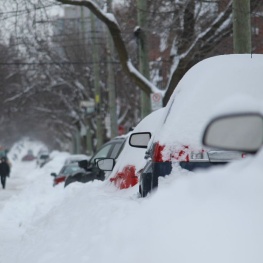Extreme Cold and Winter Storms

Due to climate change, the temperature of our atmosphere has increased, which means it can hold and then dump more water, sometimes in the form of snow. As a result, experts expect extreme weather events to increase.
When extreme weather is in the forecast, we share information to support people staying safe and healthy.
Stay safe during winter storms
The best way to stay safe during extreme winter weather is to be prepared and stay indoors! To protect yourself and your family during extreme cold, follow these safety tips:
For Yourself and Loved Ones
- Stay inside. When possible, stay indoors. See the section Resources for People Who are Unhoused below if you need information about shelters.
- Limit outdoor time for pets. Extreme cold is dangerous for animals too.
- Dress in layers. If you have to go out, dress in several loose-fitting layers. Wear a hat, mittens, and snow boots. Use a scarf to cover your mouth and face.
- Know the signs and symptoms of frostbite and hypothermia.
- Hypothermia: Warning signs include shivering, exhaustion, confusion, and slurred speech, and symptoms can look similar to intoxication. Call 911 if someone is exposed to cold temperatures and you see these symptoms.
- Frostbite: At the first signs of redness or pain in any skin area, get out of the cold or protect any exposed skin—frostbite may be beginning.
- Check on your friends, family, and neighbors. Give loved ones a call or text to make sure they’re warm and safe. People most likely to be hurt from the cold are older adults, babies, people who spend lots of time outside (e.g., the homeless, hunters), and people who drink alcohol or use drugs.
For Your Home
- Stock a home emergency kit. Your home kit should include items such as food and water, cell phone and charger, flashlight and batteries, first aid kit, important medications, a weather radio, and a change of clothes. Visit Ready Wisconsin for more items and tips.
- Prevent frozen pipes. The Red Cross has tips for preventing and thawing frozen pipes.
- Make sure you have working carbon monoxide detectors. All homes and duplexes in Wisconsin are required to have properly working detectors on every level, including the basement, but not the attic or storage areas. Detectors can be purchased at most hardware stores or online for $20-50.
- Never run a gasoline or propane heater or a grill (gas or charcoal) inside your home or garage. Any heating system that burns fuel produces carbon monoxide. Use a battery-powered detector where you have fuel burning devices but no electric outlets, such as in tents, cabins, and RVs.
- Run generators at a safe distance (at least 20 feet) from the home. Never run a generator in the home or garage, or right next to windows or doors.
- Remove snow safely. Wear sturdy, rubber-soled boots to help prevent slips and falls. To prevent injuries while shoveling, try pushing the snow with short strokes instead of lifting it. Also, use your leg muscles and not your lower back to move the shovel. Take frequent breaks to warm up inside and rest your muscles.
For Your Car
- Winterize your car. Just as you have a home emergency kit, you need one for your car too. Pack items such as blankets, snacks and water, a shovel, jumper cables, and sand. Visit Ready Wisconsin for more items and tips. Keep your gas tank at least half-full.
- Plan ahead. Keep your gas tank at least half-full, keep your cellphone fully charged, and tell family or friends where you are going and when you expect to return.
- Stay put if you get stuck. Stay in your car or truck; it’s easy to get disoriented if wind is blowing the snow around. Run the motor about ten minutes each hour for heat, only after ensuring that your exhaust pipe and radiator are not blocked by snow or debris. Make yourself visible to rescuers. Turn on the dome light at night when running the engine. Tie a bright colored cloth (preferably red) to your antenna or door. After the snow stops falling, raise the hood to indicate trouble.
Resources for People Who are Unhoused
On designated Cold Weather Nights, people who are unhoused are welcome at area homeless shelters regardless of usual capacity and shelter night limits.


